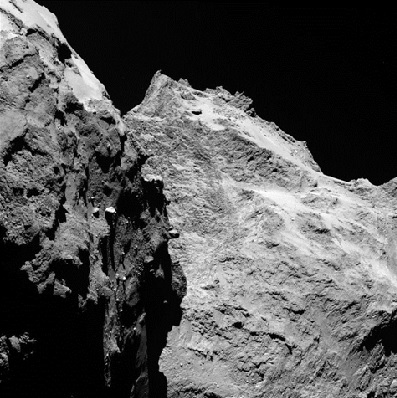15 September 2014

Fig. 1
A spectacular view of Comet 67P, acquired by the European Rosetta spacecraft, from just 62 km from the comet. The image shows rugged terrain and massive boulders.
Credit: ESA/Rosetta/MPS for OSIRIS Team MPS/UPD/LAM/IAA/SSO/INTA/UPM/DASP/IDA
The European Space Agency (ESA) recently published a magnificent image (Fig. 1) of Comet 67P, obtained by the comet-bound Rosetta spacecraft. Rosetta was only 62 km above 67P. The image, taken on 5 September 2014, reveals, in breathtaking detail, rugged terrain and huge rocks.
Comet 67P orbits the Sun every 6.45 years, in an elliptical orbit. Its distance from the Sun varies between about 186 million km and 850 million km. Its axial rotation period is only 12.7 hours.
Comet 67P is a small icy object, measuring 4 km across. Its surface is very dark, reflecting only 4% of incident sunlight. The escape velocity from 67P is only 0.46 m/s. Therefore, a little jump is enough for an astronaut, to launch into space, from the comet’s surface.
Rosetta launched on 2 March 2004, aboard the powerful Ariane 5 rocket, from the Guiana Space Center, and arrived at 67P, on 6 August 2014, to conduct the most detailed study of a comet ever. It is 2.8 meters wide and had a launch weight of nearly 3,000 kg. It is scheduled to send a small probe, to land on the surface of 67P, in November 2014.
Comets are believed to primitive objects, holding secrets of the birth of the solar system, as their chemical composition remained essentially unchanged.
References
ESA Website
Wikipedia
Aymen Mohamed Ibrahem